Biblical celebrations reveal a deep tapestry of joy and reflection, inviting us to explore their enduring relevance in our lives today.
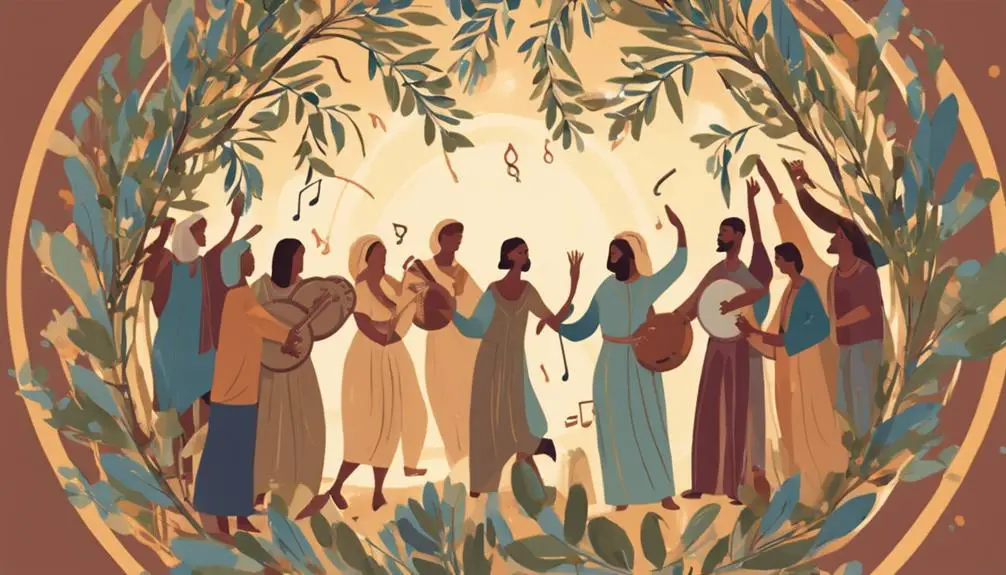
Celebration in the Bible
Like a river that overflows with spring's thaw, celebration in the Bible bursts forth with life and significance. You'll find that these events are more than mere historical footnotes; they're foundational to understanding a rich cultural and spiritual heritage.
From the liberation joy of Passover to the reflective gratitude of the Feast of Weeks, the biblical narrative weaves a tapestry of celebration deeply rooted in liberation, thanksgiving, and communal memory.
Yet, one might wonder how these ancient celebrations resonate in today's world. Uncovering their enduring relevance offers a compelling journey, one that beckons you closer, inviting you to explore the depths of joy and reflection found within these sacred traditions.
Key Takeaways
- Biblical celebrations integrate music, dance, and communal gatherings to express joy and divine favor.
- Festivals like Passover and the Feast of Weeks embody themes of liberation, gratitude, and community bonding.
- The Jubilee year emphasizes freedom, restoration, and environmental sustainability through unique practices like land redistribution and debt cancellation.
- The Feast of Trumpets, marking Rosh Hashanah, uses the trumpet's blast as a spiritual alarm for reflection, repentance, and rejoicing.
Biblical Foundations of Celebration
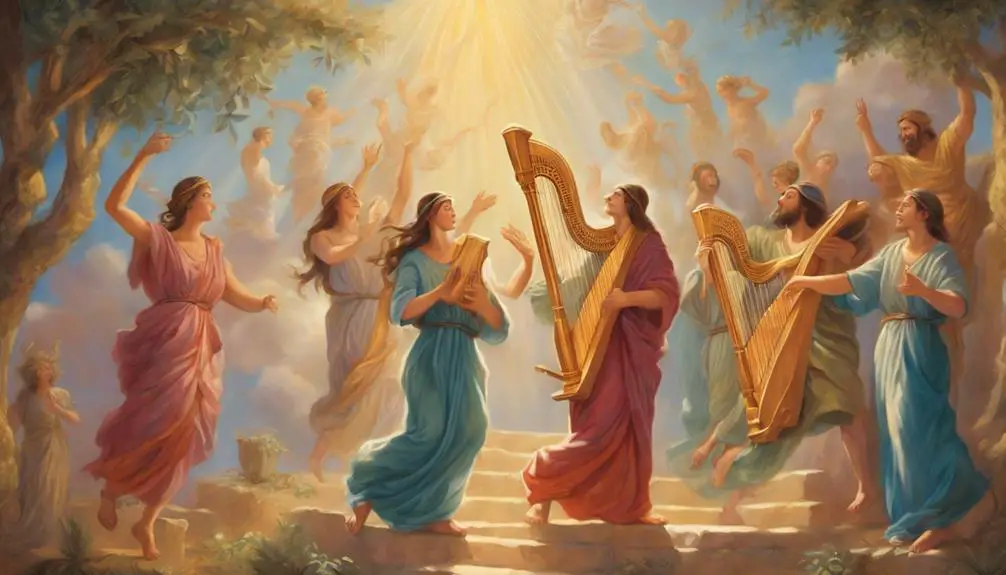
Exploring the biblical foundations of celebration reveals a rich tapestry of religious and cultural practices deeply embedded in ancient texts. You'll find that these narratives aren't just historical accounts but also serve as symbolic frameworks for understanding the spiritual significance of joy and communal gatherings. The Wedding at Cana and the Song of Miriam stand out as pivotal moments that encapsulate the essence of celebration within a biblical context.
The Wedding at Cana, as recounted in the New Testament, isn't merely a story about Jesus performing his first miracle by turning water into wine. It's a profound illustration of transformation and divine abundance at a communal celebration. This event signifies the blessing of new beginnings and the joy inherent in human connections, underpinning the theological importance of marriage and community in Christian doctrine.
Similarly, the Song of Miriam, found in the Old Testament, is a triumphant celebration of deliverance and freedom. After crossing the Red Sea, Miriam's song and dance underscore the communal expression of gratitude and joy towards divine intervention. This act of worship through celebration highlights the integral role of music and dance in expressing religious ecstasy and communal solidarity in ancient Israelite culture.
Both instances demonstrate how celebrations aren't just social events but are imbued with deep religious significance. They serve as conduits for expressing theological themes such as divine providence, joy, and community. Through analyzing these events, you gain a nuanced understanding of how celebration is woven into the fabric of biblical narratives, offering insights into the spiritual and communal life of ancient societies.
Passover: A Joyous Liberation
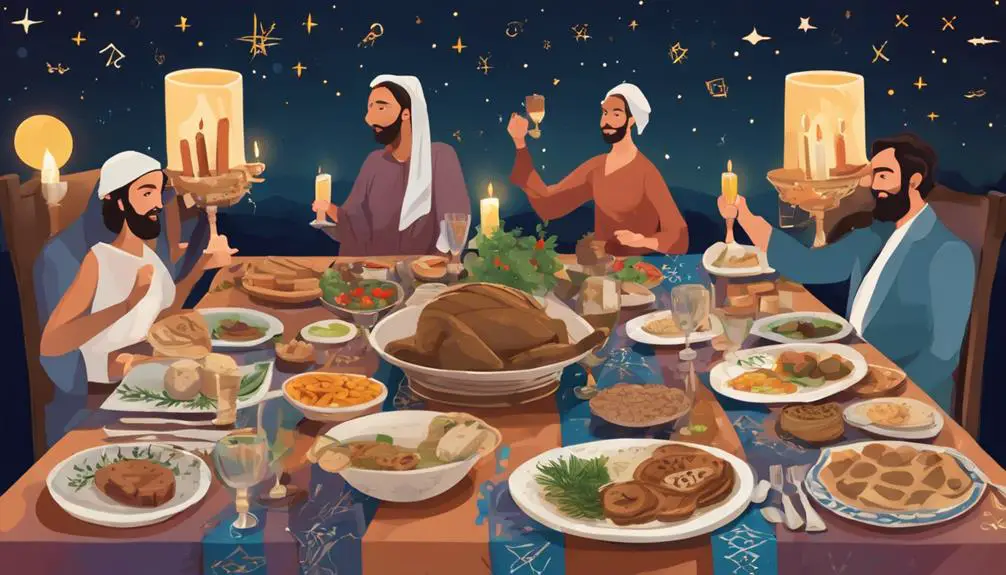
Why does Passover stand as a paramount example of joyous liberation in the biblical narrative, embodying both the physical and spiritual emancipation of an entire people? Passover, or Pesach in Hebrew, commemorates the Israelites' exodus from Egypt, marking not just a departure from physical bondage but also the birth of a nation under God's guidance.
The celebration of Passover is rich in symbolism and ritual, most notably the Seder meal, which serves as a retelling of the liberation story. This meal is a profound educational experience, designed to transmit the values of freedom and faith from generation to generation.
Key aspects of Passover that highlight its significance include:
- The Seder Meal: Beyond a mere commemorative dinner, the Seder is a ritual-packed feast that includes reading from the Haggadah, eating symbolic foods, and singing songs. Each element of the meal serves to remind participants of the bitterness of slavery, the haste of their ancestors' flight, and the sweetness of freedom.
- The Ten Egyptian Plagues: The recounting of the plagues visited upon Egypt is central to the Passover story, symbolizing the lengths to which the divine will go to liberate the oppressed. These narratives underscore a belief in divine justice and intervention.
- The Passing Over: The origin of the term 'Passover' reflects the act of divine mercy, where the houses of the Israelites were passed over during the final devastating plague. This event signifies protection and election by God.
- Unleavened Bread (Matzah): The consumption of Matzah during Passover commemorates the Israelites' hasty departure from Egypt, symbolizing purity, simplicity, and the readiness for liberation.
Passover thus stands as a multifaceted celebration, deeply interwoven with themes of deliverance, divine providence, and the unbreakable spirit of a people yearning for freedom.
Feast of Weeks: Harvest Thanksgiving
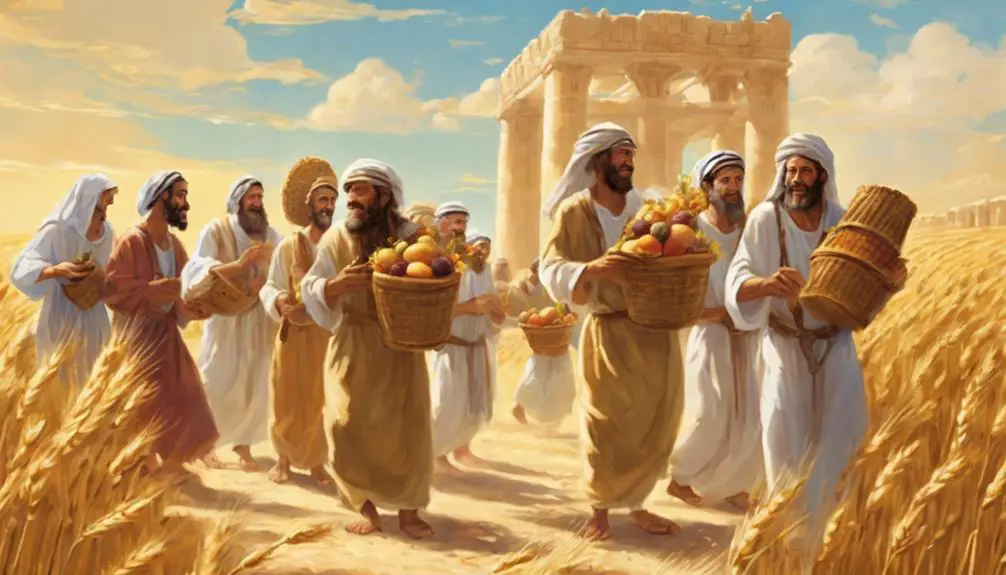
Following Passover, the Feast of Weeks, known as Shavuot in Hebrew, serves as a pivotal celebration that marks the culmination of the spring barley harvest and the anticipation of the summer wheat harvest in ancient Israel. This feast, deeply rooted in agricultural origins, emphasizes the importance of the land's fertility and the community's dependence on divine providence for sustenance. It's a time when you'd witness the tangible results of your labor and the blessings bestowed upon your crops.
At its core, the Feast of Weeks transcends its agricultural significance to embody a profound sense of community bonding. It's a period when families, neighbors, and even strangers come together, sharing in the fruits of their collective labor. This shared experience not only strengthens communal ties but also instills a sense of collective gratitude and dependence on a higher power for the seasonal yields.
Historically, this festival required you to make a pilgrimage to the Temple in Jerusalem, offering the first fruits of your harvest as a gesture of thanksgiving. This act of offering wasn't merely a religious ritual; it was a public declaration of your faith and reliance on the land's bounty, which, in turn, reinforced the societal bond amongst the Israelites.
Analyzing the Feast of Weeks reveals its dual function: as a critical agricultural milestone and as a catalyst for fostering strong community relationships. Its celebration underscores the interconnectedness of religious faith, gratitude for the earth's produce, and the reinforcement of communal bonds, themes that are as relevant today as they were in ancient times.
The Jubilee Year: Freedom and Restoration
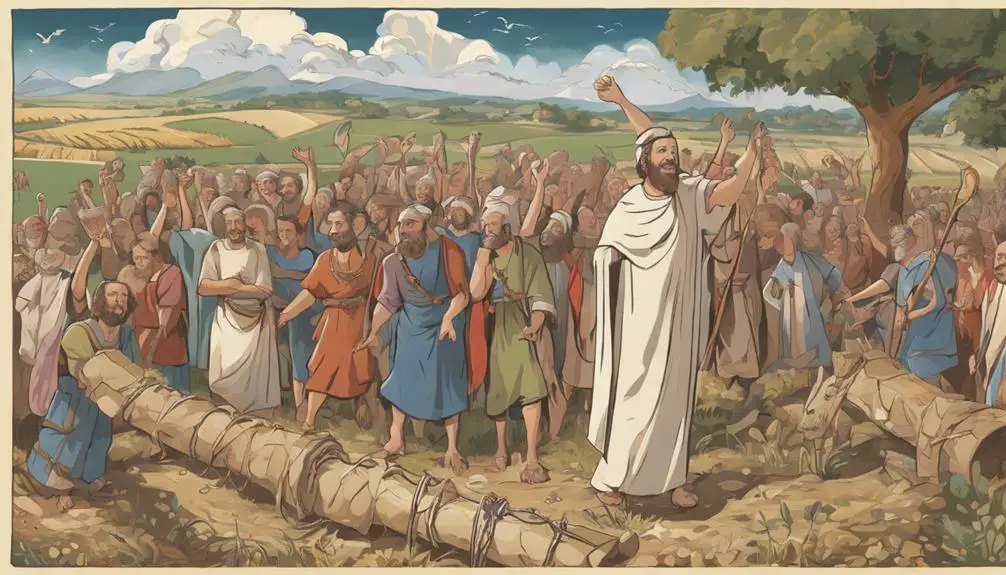
The Jubilee Year, mandated every fiftieth year in the Levitical law, embodies the principles of freedom and restoration, offering a profound societal reset for ancient Israelites. This period was marked by several key practices aimed at ensuring economic balance and social equity, reflecting a divine mandate for a just society.
Central to the Jubilee Year were:
- Land Redistribution: Initially, land in Israel was divided among tribes and families. However, over time, economic disparities could cause families to sell their land. The Jubilee Year mandated the return of sold land to its original owners or their heirs, preventing the permanent loss of familial inheritance and ensuring economic balance.
- Debt Cancellation: Debts accumulated over the years were forgiven during the Jubilee. This alleviated the burden on those who'd fallen into poverty, allowing them a fresh start and preventing a permanent underclass from forming.
- Release of Slaves: Individuals who'd sold themselves into servitude due to economic hardship were granted freedom, reuniting families and restoring social fabric.
- Rest for the Land: The land itself was given a year of rest, with farming activities halted. This allowed the land to recover, promoting environmental sustainability.
The Jubilee Year's framework of land redistribution and debt cancellation was revolutionary, offering a model for addressing economic disparity and promoting a more equitable society. It highlighted the importance of periodic systemic resets to mitigate the accumulation of wealth in the hands of a few, ensuring freedom and restoration for all members of society.
The Last Supper: Communion and Memory
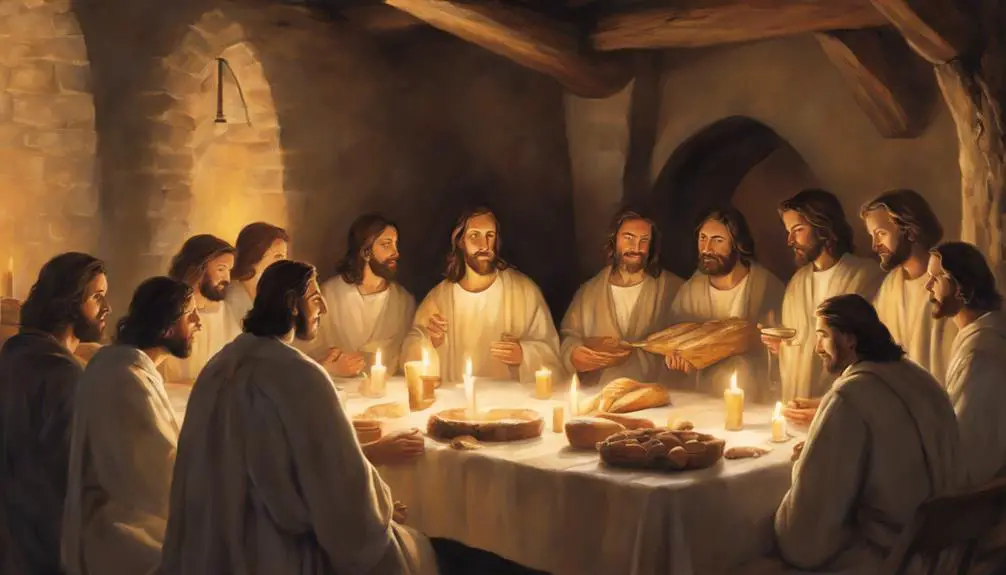
While the Jubilee Year set a precedent for societal restoration and freedom, another profound biblical event, the Last Supper, introduces a different dimension of liberation through the act of communion and the power of memory. This pivotal moment, shared between Jesus and His disciples, encapsulates the essence of communion as an act of remembering and a form of spiritual liberation. You're invited to explore the depths of this event, not just as a historical moment, but as one rich in cultural context and immortalized through artistic depictions.
The Last Supper, as described in the New Testament, serves as the foundation for the Christian practice of Communion, where believers partake in bread and wine in remembrance of Jesus' sacrifice. This act transcends mere ritual; it's a profound engagement with the past, making the sacred history present and palpable. The cultural context of the Last Supper, rooted in the Passover meal, adds layers of meaning to this act of remembrance, emphasizing liberation and covenant renewal.
Artistic depictions of the Last Supper, from Leonardo da Vinci's iconic fresco to modern interpretations, further enrich its narrative by offering visual reflections on its theological and cultural significance. These artworks invite you to delve deeper into the event's nuances, exploring themes of betrayal, fellowship, and the anticipation of sacrifice. They don't just represent a moment in time; they're a gateway to understanding the collective memory and identity shaped by the Last Supper.
As you reflect on the Last Supper's enduring legacy, consider how it exemplifies the power of memory in sustaining community and faith across generations. This biblical event challenges you to appreciate the intricate interplay between cultural context, artistic expression, and spiritual practice in commemorating profound moments of liberation and covenant.
Feasts of Trumpets: A Call to Rejoice
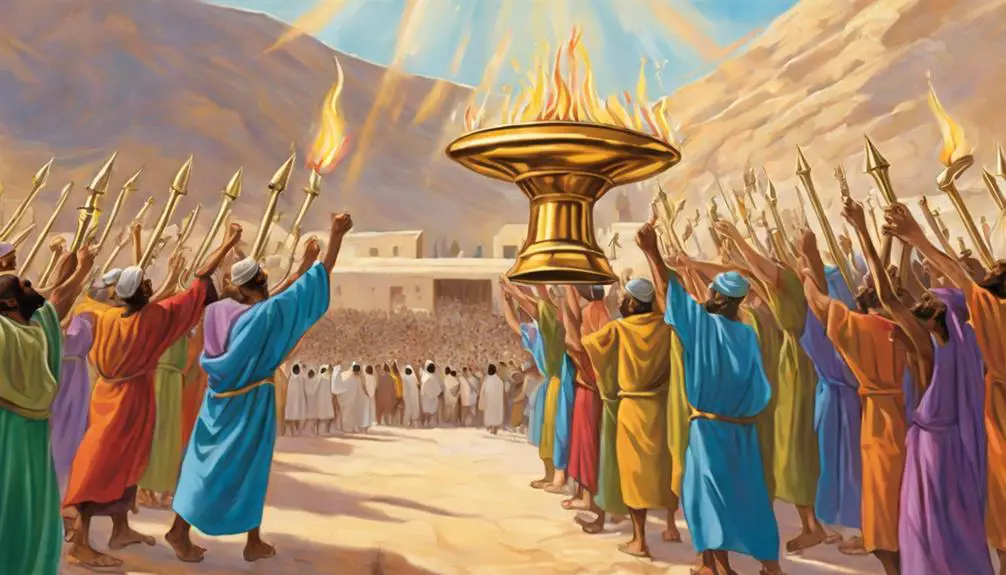
In an exploration of biblical celebrations, the Feast of Trumpets stands out as a pivotal event, inviting believers to engage in a time of joyous reflection and communal rejoicing. This feast marks the beginning of the Jewish New Year, Rosh Hashanah, and is rich in symbolism and tradition, deeply rooted in the scriptures. Understanding its significance requires a closer look at the elements that define this celebration, particularly the trumpet's role and the rituals of rejoicing.
- Trumpet Significance: In biblical times, the trumpet, specifically the shofar, was more than a musical instrument; it was a call to action, a signal for assembly, and a reminder of God's presence among His people. During the Feast of Trumpets, the sounding of the trumpet serves as a spiritual alarm, awakening souls to reflection and repentance, and heralding a period of divine judgment and mercy.
- Rejoicing Rituals: The feast isn't merely a time of solemn introspection; it embodies several rituals of joy:
- Gathering of the community to hear the shofar's blast, symbolizing unity and collective remembrance.
- Recitation of prayers and blessings, acknowledging God's sovereignty and expressing hope for a fruitful year.
- Sharing of festive meals, reinforcing bonds among family and friends, and reflecting the abundance God provides.
- Offering of sacrifices, an act of worship and gratitude towards God's continuous provision and forgiveness.
Analyzing the Feast of Trumpets reveals its dual nature: a summons to self-examination and a call to rejoice in the community's shared faith and hope. This celebration encapsulates the intricate balance between reverence and joy, encouraging believers to renew their commitment to God and each other.
Frequently Asked Questions
How Do Modern Celebrations Compare to Biblical Celebrations in Terms of Customs and Significance?
You'll find that modern celebrations often differ greatly from their historical counterparts, especially in terms of customs and significance.
While seasonal alignment once dictated many ancient festivities, today's celebrations mightn't strictly adhere to these timings, reflecting broader cultural adaptation.
This evolution in how we commemorate events showcases a blend of preserving tradition and embracing new interpretations, indicating a dynamic interplay between staying true to origins and accommodating contemporary societal values.
Are There Any Biblical Celebrations That Are No Longer Observed Today, and What Led to Their Discontinuation?
You're diving into an ocean of forgotten traditions when you explore celebrations that have vanished from modern practice. Historical context and cultural shifts have swept away some observances that once marked significant moments for ancient communities.
Analyzing these lost celebrations, you uncover the layers of societal evolution and religious transformation that led to their discontinuation. It's a scholarly journey through time, shedding light on how changing values and beliefs reshape communal expressions of joy and reverence.
How Do Different Christian Denominations Interpret and Celebrate Biblical Feasts in Contemporary Times?
You're delving into how modern Christian groups interpret and celebrate feast days, noting significant denominational differences. Each faction brings its unique theological lens to these observances, leading to varied practices and significances attached to the feasts.
This diversity in feast interpretations underscores the rich tapestry of Christian tradition. Analyzing these differences not only offers insight into contemporary worship but also highlights the evolving nature of religious observance across Christian denominations.
Can Biblical Principles of Celebration Be Applied to Secular or Non-Religious Events, and if So, How?
You're curious if universal themes in celebrations can cross into secular events through cultural adaptation. Indeed, they can. By analyzing biblical principles of celebration—community, gratitude, and renewal—you'll find these core values aren't confined to religious observances.
They're universally applicable, enhancing secular events by fostering a deeper sense of connection and meaning. So, applying these principles isn't just possible; it's a way to enrich any celebration by embedding it with timeless values.
What Role Do Music and Dance Play in Biblical Celebrations, and How Does This Compare to Their Role in Modern Religious Festivities?
In examining the role of music and dance in festivities, you'll find sacred instruments and prophetic dancing are pivotal. These elements bridge the ancient with the contemporary, enhancing spiritual connectivity.
Historically, sacred instruments signaled celebration, while prophetic dancing expressed divine messages. Today, their essence persists in modern religious events, though the forms may evolve.
This continuity highlights the enduring nature of music and dance as mediums of expression and celebration across eras.
Conclusion
In conclusion, you've journeyed through the biblical tapestry of celebration, from the liberation of Passover to the communal remembrance of the Last Supper. These ancient festivities, like spiritual flash mobs, call the faithful to rejoice, reflect, and renew their commitments.
They're not mere historical footnotes but vibrant reminders that joy, gratitude, and freedom are perennially woven into the human condition. In understanding these celebrations, you grasp not only their historical context but their enduring relevance in shaping communal and individual identities.


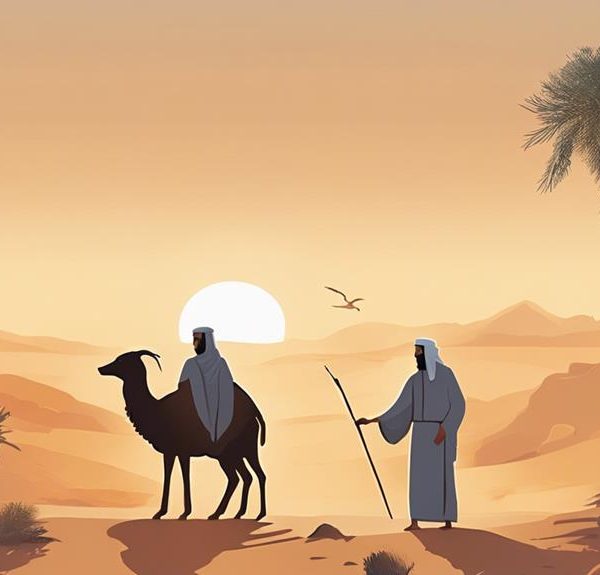
Sign up